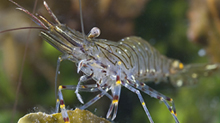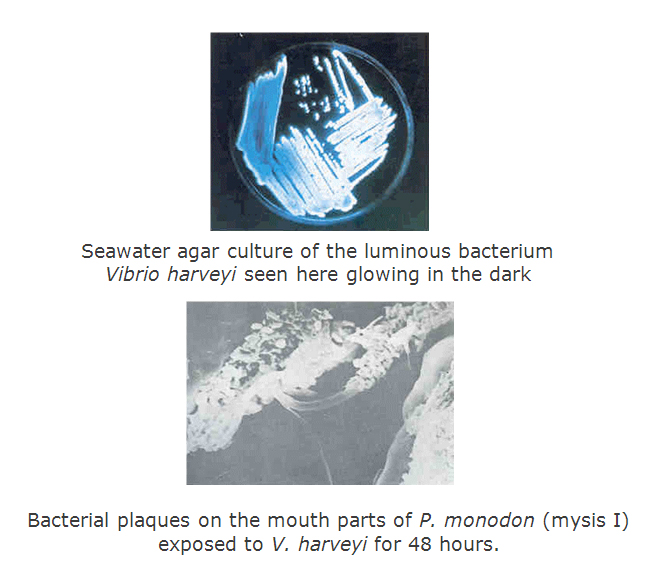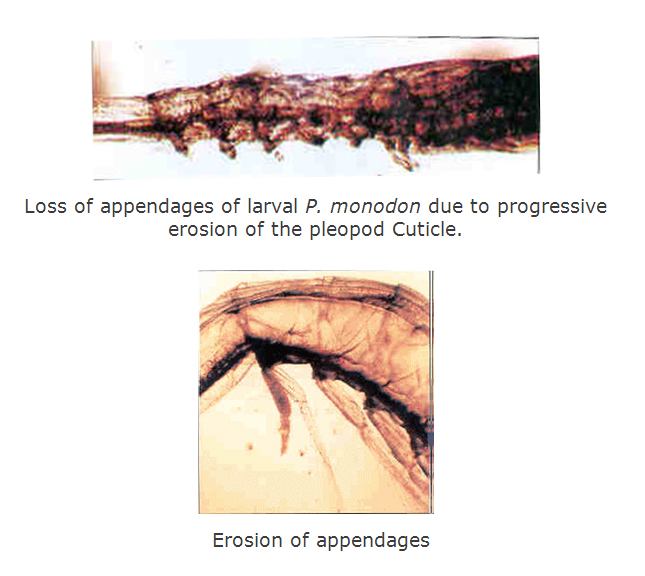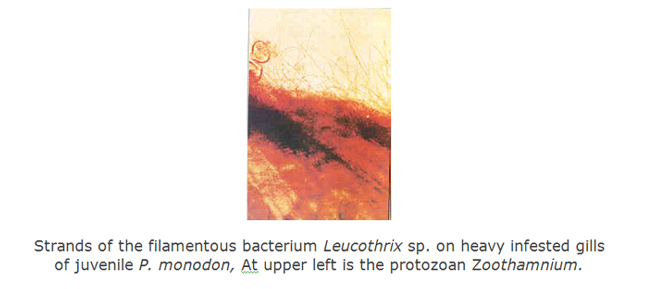Bacterial diseases

Bacterial diseases
In shrimp aquaculture bacterial diseases may cause a range of problems ranging from mass mortalities to growth retardation and sporadic mortalities. Lack of disease management and preventive practices has caused the collapse of a number of shrimp farms. Some of the most important bacterial diseases are:
A. Luminous Bacterial Disease
Causative agent: Vibrio harveyi, V. splendidus.
Species affected: P. monodon, P. vannamei, P. merguiensis, P. indicus
Stages affected: Eggs, larvae, postlarvae
Gross signs:
- Larvae become weak and opaque-white.
- Heavily infected larvae exhibit a continuous greenish luminescence when observed in total darkness. When viewed under the microscope, the internal tissues of these larvae are densely packed with highly motile bacteria.
Effects on host:
- Systemic infections result in mortalities in larvae and postlarvae, reaching up to nearly 100% of affected population.
Preventive methods:
- Prevent the entry of luminous bacteria into the hatchery system by using ultraviolet-irradiated water or by employing a series of filtration equipment (sand filters, filter bag, cartridge filters, 0.45 micron pore-sized micro-filter, etc.) and chlorination procedures.
- Adhere to strict sanitation procedures prior to and during the larval stages of growth.
- Use only previously chlorinated water during spawning and rearing to ensure a clean environment for newly hatched and developing larvae.
- Siphon out sediments and debris from the tank bottom since these could serve as substrates for bacterial growth.
- Disinfect infected stock before finally discarding them followed by a complete clean up and disinfection of hatchery paraphernalia after every larval rearing period.
Treatment:water change must be 80 to 90% replacement daily and weekly water application of ViraNil

B. Shell Disease, Brown/Black Spot, Black Rot/Erosion, Blisters, Necrosis of Appendages.
Causative agent: Shell-degrading bacteria belonging to Vibrio,
Aeromonas, and Pseudomonas groups.
Species affected: P. monodon, P. vannamei, P. merguiensis, P. indicus
Stages affected: Larvae, postlarvae, juveniles, adults
Gross signs:
- Appearance of brownish to black erosion of the carapace, abdominal segments, rostrum, tail, gills and appendages.
- Blister containing cyanotic gelatinous fluid may develop on the carapace and abdominal segment. The blister may extend to the underside of the ventro-lateral section of the carapace creating a bulge on the underside.
- In larval and post-larval stages, the affected appendage shows a cigarette butt-like appearance.
Effects on host:
- Infection is usually initiated at site of punctures or injuries made from telson or rostrum, cracks on the abdominal segment from sudden flexure of the shrimp body, or from other damage caused by cannibalism.
- Progressive erosion of these exoskeletal lesions follows upon entry and multiplication of bacterial pathogens. The infection may lead to loss of the affected appendage(s) or of the exoskeleton and may reach the underlying musculature. When these occur, normal locomotion or molting is hampered and may result in shrimp losses.
- The affected shrimp becomes susceptible to cannibalism or dies from stress or energy exhaustion.

Preventive methods:
- Maintain good water quality.
- Keep organic load of the water at low levels by removing sediments, especially dead shrimps and molted exoskeletons which harbor high number of bacteria on the lesions.
- Provide adequate diet.
- Minimize handling and avoid overcrowding.
- Avoid injuries to the exoskeleton of the shrimps to prevent the development of primary portals of entry.
Treatment:
- Induce moulting as the condition is eliminated upon moulting except when underlying tissues are damaged followed by weekly water application of ViraNil.
C. Filamentous bacterial Disease
Causative agent: Leucothrix sp.
Species affected: P. monodon, P. merguiensis, P. indicus.
Stages affected: Larvae, postlarvae, juveniles. Adults.
Gross signs:
Presence of fine, colorless, thread-like growth on the body surface and gills as seen under a microscope.
Effects on host:
- Infected eggs show a thick mat of filaments on the surface which may interfere with respiration or hatching.
- In larvae and postlarvae, filamentous growth on appendages and body surface may interfere with normal locomotory process and with molting, and may entrap other microorganisms (like fungal spores), which may initiate a new infection.
- Larval shrimps are less prone to infestations by filamentous bacteria than post-larval, juvenile, and adult stages due to the rapid succession of molts throughout the different larval stages. Frequent molting does not allow adequate time for the bacterial to accumulate on the exoskeleton.
- In larger shrimps, filamentous bacteria on the gills and other body surfaces may result in respiratory distress at the point of attachment. An indirect effect of such filamentous growth on the host is entrapment of algae and debris which interfere with respiration and promote further fouling. >
- Mortalities due to direct and indirect effects of filamentous bacteria have been reported.
Preventive methods:
Maintain good water quality with optimum dissolved oxygen level and low organic matter levels.

Treatment:
ViraNil static treatments at shrimp hatchery and in ponds.
Suggested Products
- Address
- Neospark Drugs and Chemicals Private Limited Corporate Center,
241, B.L. Bagh, Panjagutta,
Hyderabad- 500 082,
Telangana, India.
- Product Groups
- Poultry
- Large Animal
- Aquaculture
- Feed
© 2025 Neospark Drugs and Chemicals Private Limited